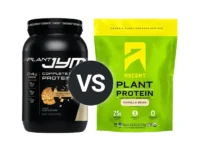Knowledge BaseYou're Questions Answered
How much plant protein powder should I use?
Plant protein powder is a popular supplement derived from various plant sources such as peas, rice, hemp, and soy. It is often used by vegetarians, vegans, and individuals looking for a plant-based protein source. The appropriate amount of plant protein powder to use depends on individual factors, including protein needs, dietary goals, and overall daily protein intake.
General Guidelines for Plant Protein Powder Intake
1. Daily Protein Requirements
The Recommended Dietary Allowance (RDA) for protein for the average adult is approximately 0.36 grams of protein per pound of body weight (0.8 grams per kilogram). However, individuals with higher protein needs, such as athletes or those engaging in regular resistance training, may require more protein—typically around 0.54 to 0.91 grams per pound of body weight (1.2 to 2.0 grams per kilogram)1. It's essential to consider all sources of protein in your diet when calculating your intake.
2. Typical Serving Size
A typical serving size of plant protein powder varies depending on the type of protein and the brand. Generally, a serving provides around 15 to 25 grams of protein, with a typical serving size being approximately 30 grams (about 1 scoop)2. The protein content may differ based on the source, with some blends providing a complete amino acid profile by combining different plant proteins.
3. Number of Servings Per Day
For most individuals, consuming one to two servings of plant protein powder per day can help meet daily protein requirements, especially when combined with protein from whole food sources. For those with higher protein needs, additional servings may be necessary. It is important to balance protein intake with other nutrients and stay within recommended daily intake levels.
Individual Considerations
- Complete vs. Incomplete Proteins: While some plant proteins are incomplete, lacking one or more essential amino acids, they can be combined with other plant proteins to create a complete amino acid profile. Blended plant protein powders often address this by including multiple sources such as pea and rice protein.
- Digestive Tolerance: Plant proteins can vary in digestibility. Individuals new to plant protein powders should start with smaller amounts to assess digestive tolerance, as some plant proteins may cause digestive discomfort in certain individuals.
- Dietary Goals: Your protein intake should align with your dietary goals, whether they include muscle building, weight loss, or maintenance. Plant protein powders can help increase protein intake while adhering to a plant-based diet.
- Phillips, S. M., & Van Loon, L. J. C. (2011). Dietary protein for athletes: From requirements to optimum adaptation. Journal of Sports Sciences, 29(sup1), S29-S38.
- Messina, M., & Messina, V. (2010). The role of soy in vegetarian diets. Nutrients, 2(8), 855-888.
Related Questions

Your Answer
We are a participant in the Amazon Services LLC Associates Program, an affiliate advertising program designed to provide a means for us to earn fees by linking to Amazon.com and affiliated sites.






